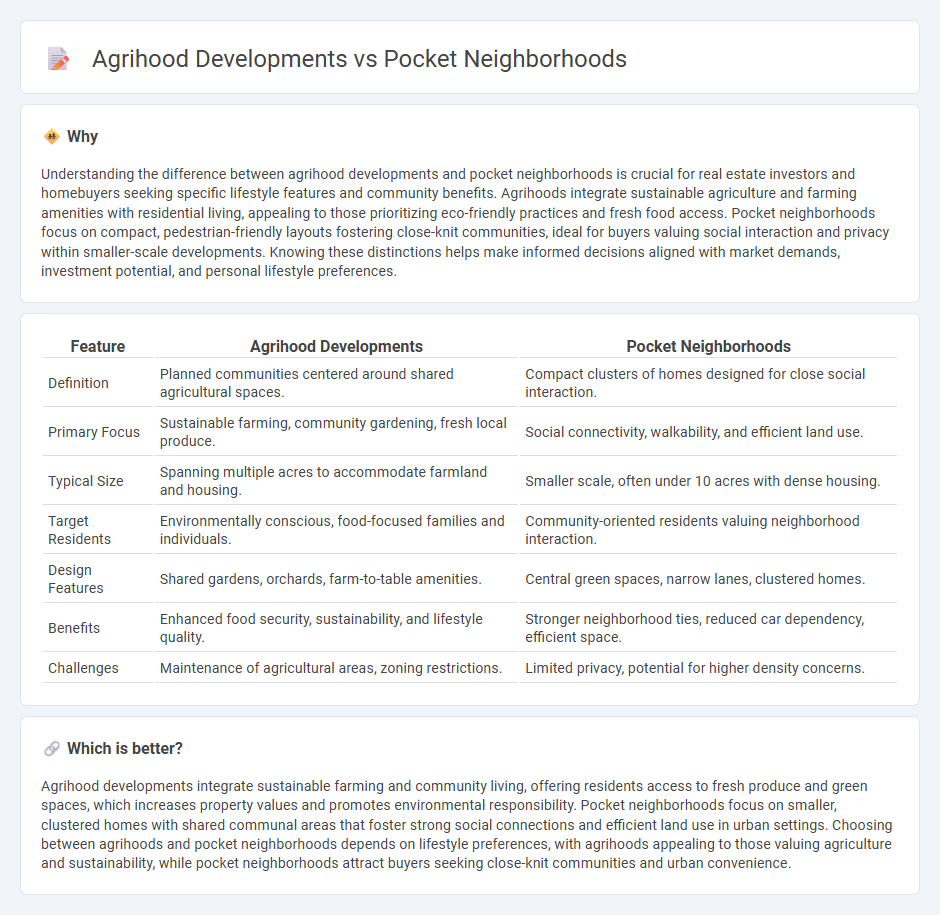
Agrihood developments integrate sustainable agriculture with residential living, offering community gardens, farm-to-table experiences, and green spaces that enhance property values and promote eco-friendly lifestyles. Pocket neighborhoods focus on compact, walkable layouts with shared open spaces, fostering close-knit communities and efficient land use in urban or suburban settings. Explore how these innovative real estate models redefine neighborhood living and investment potential.
Why it is important
Understanding the difference between agrihood developments and pocket neighborhoods is crucial for real estate investors and homebuyers seeking specific lifestyle features and community benefits. Agrihoods integrate sustainable agriculture and farming amenities with residential living, appealing to those prioritizing eco-friendly practices and fresh food access. Pocket neighborhoods focus on compact, pedestrian-friendly layouts fostering close-knit communities, ideal for buyers valuing social interaction and privacy within smaller-scale developments. Knowing these distinctions helps make informed decisions aligned with market demands, investment potential, and personal lifestyle preferences.
Comparison Table
| Feature | Agrihood Developments | Pocket Neighborhoods |
|---|---|---|
| Definition | Planned communities centered around shared agricultural spaces. | Compact clusters of homes designed for close social interaction. |
| Primary Focus | Sustainable farming, community gardening, fresh local produce. | Social connectivity, walkability, and efficient land use. |
| Typical Size | Spanning multiple acres to accommodate farmland and housing. | Smaller scale, often under 10 acres with dense housing. |
| Target Residents | Environmentally conscious, food-focused families and individuals. | Community-oriented residents valuing neighborhood interaction. |
| Design Features | Shared gardens, orchards, farm-to-table amenities. | Central green spaces, narrow lanes, clustered homes. |
| Benefits | Enhanced food security, sustainability, and lifestyle quality. | Stronger neighborhood ties, reduced car dependency, efficient space. |
| Challenges | Maintenance of agricultural areas, zoning restrictions. | Limited privacy, potential for higher density concerns. |
Which is better?
Agrihood developments integrate sustainable farming and community living, offering residents access to fresh produce and green spaces, which increases property values and promotes environmental responsibility. Pocket neighborhoods focus on smaller, clustered homes with shared communal areas that foster strong social connections and efficient land use in urban settings. Choosing between agrihoods and pocket neighborhoods depends on lifestyle preferences, with agrihoods appealing to those valuing agriculture and sustainability, while pocket neighborhoods attract buyers seeking close-knit communities and urban convenience.
Connection
Agrihood developments and pocket neighborhoods both emphasize community-centric living by integrating shared green spaces that foster social interaction and sustainable lifestyles. Agrihoods focus on agricultural features such as community farms and gardens, promoting local food production and environmental stewardship. Pocket neighborhoods complement this by clustering homes around common areas to enhance neighborly connections and optimize land use within these agrarian-focused developments.
Key Terms
**Pocket Neighborhoods:**
Pocket neighborhoods consist of small clusters of homes designed to maximize community interaction through shared green spaces and pedestrian-friendly layouts. These developments emphasize sustainable living and affordable housing options within compact, walkable environments. Explore deeper insights into pocket neighborhoods to understand how they foster close-knit communities and enhance urban living.
Clustered Housing
Pocket neighborhoods prioritize clustered housing with small homes arranged around shared courtyards to foster community interaction and efficient land use, often within urban or suburban settings. Agrihood developments incorporate clustered housing near agricultural or green spaces, blending residential living with access to local food production and sustainable practices. Discover how these clustered housing models impact community design and lifestyle by exploring their unique benefits.
Shared Green Space
Pocket neighborhoods prioritize intimate shared green spaces designed to foster close-knit community interactions within small clusters of homes. Agrihood developments integrate larger shared agricultural green areas that promote sustainable food production and community gardening, enhancing local biodiversity and food security. Explore how these distinct shared green space models shape community living and environmental impact.
Source and External Links
Pocket Neighborhood - Wikipedia - A pocket neighborhood is a type of planned community that fosters a close-knit sense of community around a common garden or courtyard.
Pocket Neighborhood Designed for Connection - CNU.org - Pocket neighborhoods are designed to promote social connections through mid-block cottage courts, increasing density and community interaction.
Pocket Neighborhoods - NSD Development - Pocket neighborhoods are planned communities that encourage neighborliness and community through shared spaces, appealing to a wide range of residents.
 dowidth.com
dowidth.com